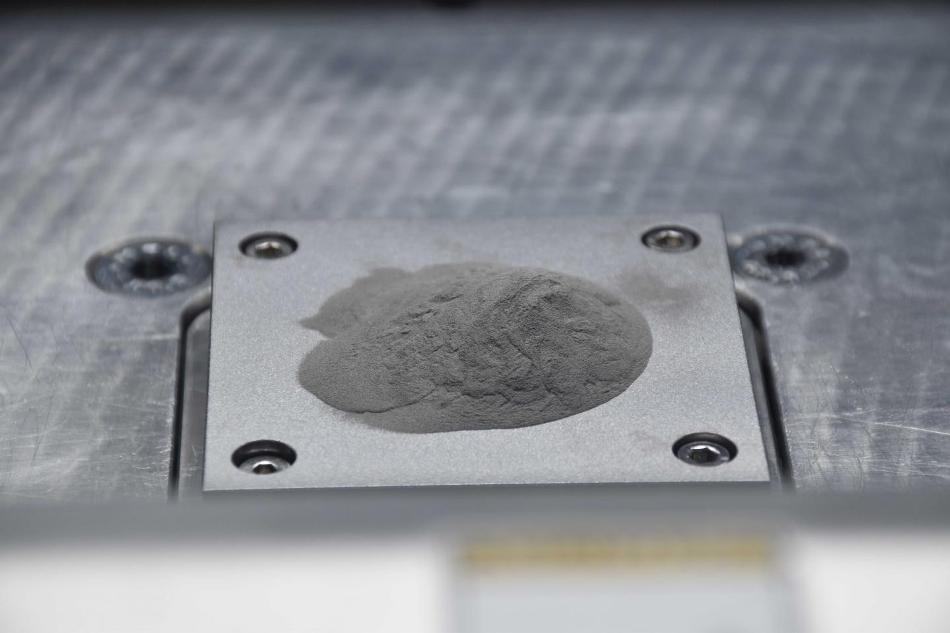Sep 21 2017
HRL Laboratories, LLC, has now brought about a revolution in metallurgy by announcing that Researchers at the renowned facility have created a technique for successfully 3D printing high-strength aluminum alloys — including types Al6061 and Al7075 — that makes room for additive manufacturing of engineering-relevant alloys.
These alloys are considered to be extremely desirable for automobile and aircraft parts and have been among thousands that were not agreeable with additive manufacturing — 3D printing — a problem that has been resolved by the HRL Researchers. An additional benefit is that their method is capable of being applied to additional alloy families such as nickel-based superalloys and strength steels that are challenging to process presently in additive manufacturing.
 The nanoparticle-functionalized powder is fed into a 3-D printer, which layers the powder and laser-fuses each layer to construct a three-dimensional object. (Credit : Photo: B. Ferguson - Copyright HRL Laboratories)
The nanoparticle-functionalized powder is fed into a 3-D printer, which layers the powder and laser-fuses each layer to construct a three-dimensional object. (Credit : Photo: B. Ferguson - Copyright HRL Laboratories)
We're using a 70-year-old nucleation theory to solve a 100-year-old problem with a 21st century machine.
Hunter Martin, Co-leader of the team
Both are Engineers in the HRL's Sensors and Materials Laboratory and PhD Students at University of California, Santa Barbara studying with Professor Tresa Pollock, a Co-author on the study. The September 21st, 2017 issue of Nature has published their paper on 3D printing of high-strength aluminum alloys.
Additive manufacturing of metals usually starts with alloy powders that are applied in thin layers and then heated with a laser or other direct heat source in order to melt and solidify the layers. Generally, if high-strength unweldable aluminum alloys such as AL6061 or Al7075 are used, the resulting parts go through severe hot cracking—a condition that reduces a metal part that can be pulled apart just like a flaky biscuit.
HRL's nanoparticle functionalization technique is capable of solving this problem by decorating high-strength unweldable alloy powders with specifically selected nanoparticles.
The nanoparticle-functionalized powder is fed into a 3D printer, which then layers the powder and laser-fuses every single layer to develop a three-dimensional object. The nanoparticles behave as nucleation sites for the desired alloy microstructure during solidification and melting, thus preventing hot cracking and permitting retention of full alloy strength in the part that has been manufactured.
It is also possible to use HRL's nanoparticle functionalization to make unweldable alloys weldable since solidification and melting in additive manufacturing is analogous to welding. This technique is also scalable and uses cost-effective materials. Standard alloy powders and nanoparticles generate printer feedstock with nanoparticles distributed in a uniform manner on the surface of the powder grains.
Our first goal was figuring out how to eliminate the hot cracking altogether. We sought to control microstructure and the solution should be something that naturally happens with the way this material solidifies.
Hunter Martin, Co-leader of the team
The HRL team enlisted Citrine Informatics in order to find the correct nanoparticles, in this case zirconium-based nanoparticles, to help them sort via the myriad possible particles in order to find the one with the properties they required.
"Using informatics was key," said Yahata. "The way metallurgy used to be done was by farming the periodic table for alloying elements and testing mostly with trial and error. The point of using informatics software was to do a selective approach to the nucleation theory we knew to find the materials with the exact properties we needed. Once we told them what to look for, their big data analysis narrowed the field of available materials from hundreds of thousands to a select few. We went from a haystack to a handful of possible needles."
This exciting new technique allows HRL to stand at the forefront of a new chapter in additive manufacturing of metals industry, defense and for research.
Other Authors on the paper included Jacob Hundley, Justin Mayer and Tobias A. Schaedler all of HRL.
Metallurgy Breakthrough: 3D Printing High-Strength Aluminum